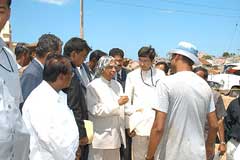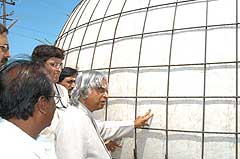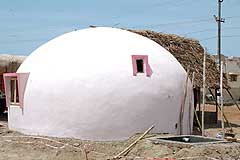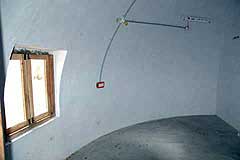Peter Tower is Building Ecoshells in India
September 27, 2005
by Peter A. Tower
Editor's Note: Peter A. Tower began contacting Monolithic early in 2005. He told David B. South, Monolithic's president, that he was an American living in India. There, Peter worked with the natives, training them to handle customer telephone inquiries from the U.S.
More calls, emails and a visit to Monolithic's headquarters in Italy, Texas followed. Through those contacts, David learned that Peter was searching for a way to improve the squalid conditions a huge percentage of the Asian population was forced to live with.
David and Peter began discussing EcoShells. Peter became convinced that these uninsulated domes would work well in India's desertlike climate and provide the inhabitants with secure shelters. Moreover, by using native labor and materials and reusing the Airforms, the EcoShells could be affordably built.
Peter began approaching government officials and various businesses and organizations with proposals for building domes. Almost immediately the idea caught on.
What follows is Peter's own account (slightly edited for reader convenience) of his experiences managing and directing the construction of one EcoShell project.
Building Ecoshells in India
by Peter A. Tower
"Toto, I've a feeling we're not in Kansas anymore."
Click Images to Enlarge |
 |
| The President of India came to inspect construction of one of Tower's EcoShells. |
 |
| "...we have started some sales efforts in the Tsunami affected areas in southern India and now have our own crews there building. A visit from the President of India, Dr. Kalam, brought us a ton of publicity, and we now face a very bright future indeed." |
 |
| Fisnished model EcoShell home in India. |
 |
| Interior of the EcoShell home. Once furnishings and a family adds their personal touches it will be a have of calm. |
I have built log homes, geodesic domes, steel frame kit homes and remodeled several older homes, but all of that pales in comparison to building simple Ecoshells in India.
My assumption was that starting a dome building company in India would be difficult, but it wasn't.
I also thought that semiskilled labor would be readily available to do this, but it wasn't. However, the time it took to train three work crews was shorter than I anticipated.
The work ethic of a motivated crew building with new technology is phenomenal. My crews are proud to work twelve-hour shifts, seven days a week, if needed. I don't ask them to; they insist on it.
There is a certain pride and definite ego component at work here. Being able to tell your friends and relatives that you are working for a Westerner in India using Western technology means something to the India worker. We pay higher than the average, but we also expect quality work. We have achieved that standard in spades!
We started working on the grounds of a horticultural exhibit center south of New Delhi called Samak Farms. This exhibit center is owned by an American-trained horticulturist and landscape architect. It is meant as a showcase visitors center to promote education as well as his plant and landscaping businesses.
I sat down with Athul at a garden center he owns near where I live, and seven minutes later he signed a contract to build three demonstration domes to house exhibits. He spoke perfect English, by the way. He immediately understood the value of Ecoshells and was intimately familiar with building with rebar and concrete, since that is practically all construction, large or small in India.
The normal fashion here, whether for house or office complex, is to build piers of heavily reinforced concrete, place horizontal forms, or shuttering as it's known here, between them, pour a floor on top of the forms, which are held up by vertical logs and then finish the walls by building with bricks between the vertical piers.
My business partner, Vivek Tiwari and I set about recruiting a crew with an eye toward having them trained as supervisors, if this little dream became a success. We started with his father, a 25-year veteran of the building trade, then his uncle, another veteran and left the choice of the rest of the team up to them. Our primary purpose was to make sure we had trustworthy personnel, since equipment here tends to grow legs and walk away, and I was funding this on my own dime.
We got our basic equipment together, which meant running all over the hardware market in Delhi, looking for things that I was used to having and India doesn't use. It was especially difficult trying to bargain with the person who could provide me with the exact hammer drill we needed, but who thought I had more money than I actually did.
After we walked out and got in our car, we got a reasonable deal, which meant I only paid twice as much as an Indian national would have. You may ask why I didn't just let Vivek do the bargaining while I stayed away. The problem is that he is not familiar with equipment specifications, load factors, etc. and I was afraid of ending up with something akin to an AA battery-powered screwdriver trying to drill and fasten in four inches of concrete.
So we, not so merrily, trooped back to the jobsite, unloaded our gear and prepared to get organized. This simple step is not normally practiced to a great degree, and in India things tend to get staged as you need them, not in an anticipatory fashion.
Teaching the crew to set up and use a checklist was interesting. The language barrier and the fact that to them my word was literally their law and livelihood made me aware of the vast status difference between us.
It took several weeks for anyone to gently suggest that perhaps I might consider, only if I felt like it of course, a different way to do this particular task. They were always right, much to my chagrin, and as we grew to trust each other, I relied on their expertise and intelligence more and more.
There is a word used with pride in India, it's known as "Jugar" and refers to the ability to adapt, invent, modify, extend, improvise or copy even when you don't seem to have the needed resources to do so. Basically it is being very clever and making do. I learned to love this concept. It is a measure of the intelligence and cleverness of Indian workmen that they view this type of adaptability as a matter of course and shrug off compliments when it is successfully employed.
We started by marking a circle 10 ft. radius (20 ft. diameter). When I went back to check on the measurement, it did not vary by even 1/8th of an inch. They removed the turf inside the circle and I rechecked. Same dimension. I thought that this boded well, and I was right.
Unlike the instructions, we first dug a trench 18 inches deep and 12 inches wide. Yup, you guessed it; it was spot-on all the way around.
We had to make our own stakes, and that was the first time our crew had seen a circular saw in action. They gathered around and muttered when they saw the power and speed of one of these puppies. Previously a carpenter and assistants would have hand sawn the points on the stakes, and it would have taken all day. This took about 20 minutes and amazed them.
Then I let Vivek's uncle try cutting some plywood sections. I showed him how to adjust the cut depth, all by demo, not much Hindi in my vocabulary, and taught him some cautions, including kickbacks. I was glad OSHA was not around, since the preferred footwear, even for welders here, are rubber flip flops. Few people can afford shoes, or even like them, since the climate in northern India is basically desertlike -- up to 120 degrees and 5% humidity interrupted by seasonal downpours.
It was with some initial trepidation that I watched that spinning blade near dark brown toes, but my fears faded after witnessing the accuracy and care with which it was being employed.
We screwed down the sections. An aside here: it had taken us three days to find drywall screws and their speed and power made another impression. Didn't take more than ten minutes of teaching and they got it. Again, done to exacting precision, every single time.
Next, we hired two guys from the local village whose specialty is placing rebar steel. They were intrigued with our technology and asked lots of questions, translated by Vivek, of course.
The way rebar is delivered is that the 30-foot lengths are bent into a bow, stacked in a truck and then dumped at the site. First you straighten them, then you have to cut them to length. This is done with a chisel on a block of steel. If you are skilled, which I'm not, two blows with a very large hammer does the trick.
We explained that we wanted a grid of steel, 15 inches on center for the foundation, and we wanted it placed two and a half inches off the ground to make sure we were in the center of the poured foundation. Needless to say that it was emplaced exactly like that, first time. Jugar came in when he measured the circumference of the airform at 15 inch heights and formed large rebar circles ahead of time and wired them in exactly. A neater, and faster way to emplace the horizontals. Less stress on the airform as well. Altogether, an elegant solution.
Screwing down the Airform using too-short Tapcon screws was a nightmare. We had to resort to sleeved concrete anchors, and they worked very well. We also decided to have long, curved brackets made for us instead of having to use the short, straight ones supplied. Easier to use, faster and more hold-down power with fewer screws needed. Jugar, indeed.
Inflating the Airform was a challenge. Due to power fluctuations and the lack of a return airflow blocking valve, the pump had to be kept running constantly and turned off when it reached our homemade pressure gauge limit. When the diesel from the site generator ran out, the entire Airform would deflate until it was restarted and refilled. We opted to buy a Honda generator for our own use and that solved the problem. The exasperation of having to monitor the air pressure and turn the pump on and off constantly to maintain correct pressure remained, and it was the only truly frustrating part of the entire building process.
Placing the first layer of concrete was a challenge, solved by my jumping in and demonstrating this procedure. Since I am the company head and am only supposed to show up once in a while, instead of actually working, this action was unprecedented in their experience and caused some consternation. The implication was that they were incapable of doing their job and implied harsh criticism. Vivek gently explained that the Westerner was crazy, liked to be hands on and to just humor him.
This diplomacy seemed to work, and we had no other crises like this. Again, shown once, they did it perfectly, and we shortly had a complete dome.
When we deflated the Airform, much heavy thumping on the shell resounded and Vivek's father sheepishly admitted that he had had his doubts about the strength of one of these, but now he was convinced.
All of the workers on the exhibition center now swarmed the site, since we had taken down the yellow warning tape and much conversation and opinion expressing ensued. To a man, and woman, they all thought this was really cool and when finding out how much Ecoshells cost here, they all wanted one.
I left those negotiations to Vivek, and we are working on doing some sort of communal building deal to keep the cost way down. Since we are building 27 more of these on the site, we have time to figure this out.
The plastering crew set to work with a vengeance and our third dome only took five days, start to finish.
Subsequently we have started some sales efforts in the Tsunami affected areas in southern India and now have our own crews there building. A visit from the President of India, Dr. Kalam, brought us a ton of publicity, and we now face a very bright future indeed.
This technology is precisely suited for this economy, climate and use, and I want to thank David South for helping to make it happen.
Related Links:
- Southern Sudan Education Project and Manute Bol Raise Funds for EcoShell School in Yomchiir
- On the Road to Nairobi: Progress on the Owiti Children's Home And Medical Centre
- Owiti Children's Home Gives Hope to Very Needy Children in Kenya
- Solid House Foundation
- EcoShells Solve World Housing Problems
- EcoShells Round the Corner
- New Oroville - A High-tech City in India
- The First Monolithic Dome Town
- Monolithic Seeks Sponsors for Developing Countries Housing Projects
177
Dome Park Place - Italy, TX 76651
Tel (972)483-7423 - Fax (972)483-6662
![]() | Press Room
| Press Room